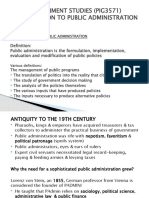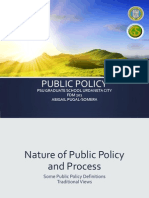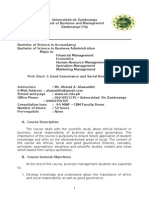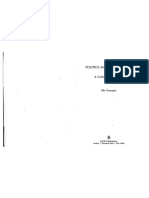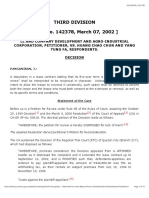0 ratings0% found this document useful (0 votes)
527 viewsHandout Lecture 1 Introduction To Public Administration
Handout Lecture 1 Introduction To Public Administration
Uploaded by
sweetmelyPublic administration (PA) is the study of administration in government, but has expanded to also include semi-governmental and non-governmental organizations. It is a multidisciplinary field that draws from various social sciences. PA has transformed into public management (PM), which investigates public affairs more broadly across multiple levels of governance and provides recommendations and training. PM produces both empirical and normative knowledge that can be applied descriptively or prescriptively. Public governance also considers coordination across different levels of government and non-governmental organizations through the policy process. Key areas of PA/PM include agenda-setting, policymaking, decisionmaking, and policy analysis.
Copyright:
© All Rights Reserved
Available Formats
Download as PPT, PDF, TXT or read online from Scribd
Handout Lecture 1 Introduction To Public Administration
Handout Lecture 1 Introduction To Public Administration
Uploaded by
sweetmely0 ratings0% found this document useful (0 votes)
527 views16 pagesPublic administration (PA) is the study of administration in government, but has expanded to also include semi-governmental and non-governmental organizations. It is a multidisciplinary field that draws from various social sciences. PA has transformed into public management (PM), which investigates public affairs more broadly across multiple levels of governance and provides recommendations and training. PM produces both empirical and normative knowledge that can be applied descriptively or prescriptively. Public governance also considers coordination across different levels of government and non-governmental organizations through the policy process. Key areas of PA/PM include agenda-setting, policymaking, decisionmaking, and policy analysis.
Original Description:
Public administration handout
Original Title
Handout lecture 1 Introduction to public administration
Copyright
© © All Rights Reserved
Available Formats
PPT, PDF, TXT or read online from Scribd
Share this document
Did you find this document useful?
Is this content inappropriate?
Public administration (PA) is the study of administration in government, but has expanded to also include semi-governmental and non-governmental organizations. It is a multidisciplinary field that draws from various social sciences. PA has transformed into public management (PM), which investigates public affairs more broadly across multiple levels of governance and provides recommendations and training. PM produces both empirical and normative knowledge that can be applied descriptively or prescriptively. Public governance also considers coordination across different levels of government and non-governmental organizations through the policy process. Key areas of PA/PM include agenda-setting, policymaking, decisionmaking, and policy analysis.
Copyright:
© All Rights Reserved
Available Formats
Download as PPT, PDF, TXT or read online from Scribd
Download as ppt, pdf, or txt
0 ratings0% found this document useful (0 votes)
527 views16 pagesHandout Lecture 1 Introduction To Public Administration
Handout Lecture 1 Introduction To Public Administration
Uploaded by
sweetmelyPublic administration (PA) is the study of administration in government, but has expanded to also include semi-governmental and non-governmental organizations. It is a multidisciplinary field that draws from various social sciences. PA has transformed into public management (PM), which investigates public affairs more broadly across multiple levels of governance and provides recommendations and training. PM produces both empirical and normative knowledge that can be applied descriptively or prescriptively. Public governance also considers coordination across different levels of government and non-governmental organizations through the policy process. Key areas of PA/PM include agenda-setting, policymaking, decisionmaking, and policy analysis.
Copyright:
© All Rights Reserved
Available Formats
Download as PPT, PDF, TXT or read online from Scribd
Download as ppt, pdf, or txt
You are on page 1of 16
1
Lecture 1 Introduction Public
Administration
drs Chris Palm
2
What is Public Administration? (1)
PA is the scientific study concerning public admini-
stration but it doesnt cover the governance concept
for its broad perspective, concerning not only
government.
It also concerns the network of (a) government + (b)
semi- and non-governmental organizations + (c) off-
shore governance located in powerful international
and regional organizations. See: Bonaire.
3
What is PA (2)?
Also PA is not the legal and political study, but also a
the multidisciplinary study from different disciplines
such as:
social sciences, law, politics, economy, philosophy
(ethics);
organization and administrative studies (like
financial studies, human resource studies, ICT and
policy studies)
This makes PA also multi-functional
What is PA (3)?
So PA is being transformed in a Public Management
(PM) or Public Governance (PG) study that doesnt
stop anymore at its legal and administration study.
PM is multi- and inter-disciplined, but goes also
further than only government and is network
governance oriented.
So we see here a confusion of thoughts. Please
explain this.
4
5
How does PM work? (1)
PM investigates public affairs in governmental,
semi- and non-governmental organizations, regional
and international organizations
It provides know-how to come to PM-products (like
recommendations or implementation of public
services)
It also provides training in public management
6
How does PA works? (2)
PM produces two sort of broad knowledge fields:
empirical knowledge (to analyze and explain facts in
the public domain)
normative knowledge (to judge governmental reality)
These knowledge fields can be used in two ways:
1. Descriptive knowledge (= describing the field)
2. Prescriptive knowledge ( = prescribing for
interventions or optimalization)
7
What is public governance? (1)
the institutional level
Nowadays public governance is considered gover-
nance of different governmental and non-
governmental levels:
Regional and international organizations
National government
Local government
Non-governmental organizations
The private sector and local civil society
For instance: child right issues
8
What is public governance? (2)
the process
Governance (= steering and coordination) of the
before mentioned complex of organizations and
society
Managing of information, decision making, imple-
mentation, execution and monitoring or supervision
Design and execution of the different steps in the
policy process (like the policy design and
implementation)
9
Crucial Applications PA & PM
Agenda setting (the decision to take action)
Policy making (e.g. project plan)
Decision making (e.g. in a Island Council)
Policy analysis (evaluation/monitoring)
Governance or coordination styles
Legislation
Budgeting
National human resource development
10
Quality Public Governance (1)
6 crucial areas of PG that reflect quality criteria
but are also conflict areas:
Democracy (like transparency)
Effectiveness (suitable solutions)
Efficiency (economic solutions)
Integrity (fairness) (essential for Trust)
Legitimacy (the lawfulness of decisions)
Mediation capacity between conflicting groups
11
Quality Public Governance (2)
Which of these 6 quality areas do you consider
from your point of view problematic in the local
government?
And which one do you consider problematic in the
PM of the islands in the Dutch kingdom?
12
Negative factors that determine the
governance quality
Financial and human resources
International and regional forces
Internal and external actors
Political win-loose games
Lack of time
Lack of information or abundant or confusing
information (like in the war against terror)
Diversity of visions and interests
13
Historical developments PA (1)
In 19
th
century we had mostly constitutional affairs
and a focus on moral and legal issues
In the 20
th
century, especially after World War II we
see influences of:
- new disciples like economy, social sciences,
and human and financial management;
- the development of more efficiency and more
democratization (like more direct or bottom-
up democracy)
14
Historical developments PA (2)
1. Corruption leads to scientific management, 1911
2. Max Weber (1920) introduces the bureaucratic
organization against corruption
3. The bounded or limited rationality of Herbert Simon
(1950) and around 1960 the development of
democratic policy sciences (Lasswell)
4. In the 90s reinventing government as a super
efficient and effective exercise (privatization)
5. In 2000 participatory and direct democracy
15
Possible examination subjects (1)
1. Please explain the shift from public administration
towards public governance. What are the
differences and causes of this shift?
2. The study of public administration stands today for
a multidisciplinary study. Of which disciplines does
it consist and what are the advantages of this
combination?
16
Possible examination subjects (2)
3. Please mention the 6 crucial areas of public
governance that reflect quality criteria and also
these conflict areas.
4. There are also negative factors that determine
governance quality. Can you explain this?
5. Please mark 5 mayor steps in the historical
development of public administration and their
corresponding dates
You might also like
- Family Law OutlineDocument5 pagesFamily Law OutlineChristian SpangenbergNo ratings yet
- The Key Concepts and Scope of Public AdministrationDocument12 pagesThe Key Concepts and Scope of Public AdministrationShumbusho Consultingtz50% (2)
- The Nature and Meaning of Public AdministrationDocument8 pagesThe Nature and Meaning of Public AdministrationHanna AberoNo ratings yet
- An Overview of Decision MakingDocument19 pagesAn Overview of Decision MakingBenjie Moronia Jr.No ratings yet
- Naga Telco Vs CADocument2 pagesNaga Telco Vs CANadzlah Bandila100% (1)
- Guarantee Letter For Visa JapanDocument4 pagesGuarantee Letter For Visa JapanRea Angela PurisimaNo ratings yet
- Government Studies (Pig3571) Introduction To Public AdministrationDocument21 pagesGovernment Studies (Pig3571) Introduction To Public AdministrationashleykabajaniNo ratings yet
- Unit 1 & 2 .pptx-2012 (PPS)Document72 pagesUnit 1 & 2 .pptx-2012 (PPS)Awetahegn HagosNo ratings yet
- Public AdministrationDocument16 pagesPublic Administrationbechuyadav100% (1)
- Approaches and Paradigms of Public AdministrationDocument32 pagesApproaches and Paradigms of Public AdministrationannNo ratings yet
- Publicpolicy 130621235359 Phpapp02Document53 pagesPublicpolicy 130621235359 Phpapp02Huỳnh Hiếu100% (3)
- Introduction To Public AdministrationDocument30 pagesIntroduction To Public AdministrationSamNo ratings yet
- Public Administration Material Part 1 Administrative TheoryDocument365 pagesPublic Administration Material Part 1 Administrative TheoryPramod Reddy RNo ratings yet
- Syllabus 5.1 Introduction To Public Administration PDFDocument5 pagesSyllabus 5.1 Introduction To Public Administration PDFChandra ChanduNo ratings yet
- Module 2020-2021Document190 pagesModule 2020-2021Asyed Silayan ZaportizaNo ratings yet
- Handouts MPA 401Document28 pagesHandouts MPA 401Muhammad Imran Irshad JalloNo ratings yet
- Nature and Scope of Public AdministratioDocument35 pagesNature and Scope of Public AdministratioCommunication ElectronicsNo ratings yet
- Module 7 - Politics and AdministrationDocument10 pagesModule 7 - Politics and AdministrationHoney Jane Tabugoc TajoraNo ratings yet
- GSRDocument12 pagesGSRAhmad AlawaddinNo ratings yet
- 1.1 Chapter 1 Public Policy Analysis by Peter KnoepfelDocument25 pages1.1 Chapter 1 Public Policy Analysis by Peter Knoepfelsikandar aNo ratings yet
- What Is Public AdministrationDocument3 pagesWhat Is Public AdministrationPujii Der MawanNo ratings yet
- Intro To Public Administration 1 1Document71 pagesIntro To Public Administration 1 1Bea PaghubasanNo ratings yet
- PA203-Theory and Practice of Public AdministrationDocument36 pagesPA203-Theory and Practice of Public AdministrationRigie Anne Gozon100% (1)
- Definitions of Public AdministrationDocument14 pagesDefinitions of Public AdministrationDayyanealos100% (1)
- Public ExpenditureDocument4 pagesPublic ExpenditureadityatnnlsNo ratings yet
- Public AdministrationDocument15 pagesPublic AdministrationAgusto Dupan50% (2)
- 4 - Public Policy AnalysisDocument11 pages4 - Public Policy AnalysisBebek AngsaNo ratings yet
- Lecture 4 - PA Theory - NPA and NPMDocument22 pagesLecture 4 - PA Theory - NPA and NPMRaikhan BerekenovaNo ratings yet
- Public PolicyDocument4 pagesPublic PolicyBurhanuddin H DahodwalaNo ratings yet
- Public Policy Analysis Final Review Public Policy Analysis Final ReviewDocument23 pagesPublic Policy Analysis Final Review Public Policy Analysis Final Reviewfadwa100% (1)
- Public AdDocument4 pagesPublic AdGail CariñoNo ratings yet
- The Study of Public AdministrationDocument32 pagesThe Study of Public Administrationedito raymund b torreNo ratings yet
- PA 111-Course Outline-1st Sem 2022-23Document7 pagesPA 111-Course Outline-1st Sem 2022-23Grazel GeorsuaNo ratings yet
- Obe Syllabus Pa 1Document7 pagesObe Syllabus Pa 1john jerick aldovinoNo ratings yet
- Chapter 9 - State and Local Bureaucracy and Administration - State and Local Government and Politics - Prospects For SustainabilityDocument31 pagesChapter 9 - State and Local Bureaucracy and Administration - State and Local Government and Politics - Prospects For SustainabilityNancy LeyvaNo ratings yet
- Public Administration Unit-2 Importance of Public AdministrationDocument7 pagesPublic Administration Unit-2 Importance of Public AdministrationDeepika SharmaNo ratings yet
- Code of Conduct ReportDocument56 pagesCode of Conduct ReportGilbert MalcolmNo ratings yet
- Public Versus Private AdministrationDocument3 pagesPublic Versus Private AdministrationAnonymous T5v5yESz0No ratings yet
- Guiler ExamDocument2 pagesGuiler Exam자기여보No ratings yet
- Department of Finance Hand OutDocument9 pagesDepartment of Finance Hand OutJonathan RiveraNo ratings yet
- Public AdministrationDocument4 pagesPublic AdministrationSohil BakshiNo ratings yet
- PubadDocument19 pagesPubadअपूर्व उत्सव झाNo ratings yet
- Taking Account of Accountability - A Conceptual Overview and Strategic OptionsDocument51 pagesTaking Account of Accountability - A Conceptual Overview and Strategic OptionsDejan Šešlija100% (2)
- Lecture 4 - Policy Instruments Policy MakersDocument77 pagesLecture 4 - Policy Instruments Policy MakersLeah Marie Lozares UntalanNo ratings yet
- Contemporary Issues in Development AdministrationDocument12 pagesContemporary Issues in Development AdministrationBen Asuelimen IJIENo ratings yet
- Bovens Public Accountability - Connex2Document35 pagesBovens Public Accountability - Connex2NazLubna100% (1)
- Politics and DevelopmentDocument103 pagesPolitics and DevelopmentMark Goeffrey Soguilon GustiloNo ratings yet
- Nature of Public AdministrationDocument137 pagesNature of Public AdministrationAbigail Yassin100% (1)
- Chapter.8 Accountability and ControlDocument17 pagesChapter.8 Accountability and ControlVikāso Jāyasavālo100% (1)
- Community and Economic DevelopmentDocument7 pagesCommunity and Economic DevelopmentEdson MutsvungumaNo ratings yet
- Understanding Public Policy PDFDocument5 pagesUnderstanding Public Policy PDFBrandon McintoshNo ratings yet
- Chapter 1 PADocument27 pagesChapter 1 PAJaya Mae RamosNo ratings yet
- DILG MC 2014-39 Seal of Good Local Governance Mar 24 2014Document13 pagesDILG MC 2014-39 Seal of Good Local Governance Mar 24 2014joreyvilNo ratings yet
- Scholarly Definitions of Public AdministrationDocument8 pagesScholarly Definitions of Public AdministrationMuhammad Umair Azam100% (1)
- What Is Economic DevelopmentDocument2 pagesWhat Is Economic DevelopmentNna Yd UJNo ratings yet
- By Ledivina V. Cariño: Zenaida L. Paday-Os Josefina B. Bitonio, DpaDocument44 pagesBy Ledivina V. Cariño: Zenaida L. Paday-Os Josefina B. Bitonio, Dpamary grace degorioNo ratings yet
- Module IDocument26 pagesModule IFayas KMNo ratings yet
- Module 1 - Politics and AdministrationDocument10 pagesModule 1 - Politics and AdministrationHoney Jane Tabugoc TajoraNo ratings yet
- Advocacy, Networking and Coordination PresentationDocument12 pagesAdvocacy, Networking and Coordination PresentationYIL- NetworkNo ratings yet
- Public Administration Theory WikipediaDocument7 pagesPublic Administration Theory WikipediaPswd MisorNo ratings yet
- Youth and Political Participation in Europe: Results of the Comparative Study EUYOUPARTFrom EverandYouth and Political Participation in Europe: Results of the Comparative Study EUYOUPARTReingard SpannringNo ratings yet
- Sierra Leone Private Investment and Financial Sector Development: Trends and StatisticsFrom EverandSierra Leone Private Investment and Financial Sector Development: Trends and StatisticsRating: 5 out of 5 stars5/5 (1)
- Asian Development Bank–Japan Scholarship Program: Annual Report 2012From EverandAsian Development Bank–Japan Scholarship Program: Annual Report 2012No ratings yet
- United States v. J. C. Long, Individually and As of The Estate of Frank J. Sottile, and The Worth Agency, A Partnership, 537 F.2d 1151, 4th Cir. (1975)Document8 pagesUnited States v. J. C. Long, Individually and As of The Estate of Frank J. Sottile, and The Worth Agency, A Partnership, 537 F.2d 1151, 4th Cir. (1975)Scribd Government DocsNo ratings yet
- Succession-Syllabus PDFDocument13 pagesSuccession-Syllabus PDFJaneNo ratings yet
- Torts and Damages Book I - Torts I. PrinciplesDocument9 pagesTorts and Damages Book I - Torts I. PrinciplespulithepogiNo ratings yet
- British American Tobacco vs. CamachoDocument7 pagesBritish American Tobacco vs. CamachoLisa BautistaNo ratings yet
- Difference Between Temprorary and Permanent InjunctionDocument7 pagesDifference Between Temprorary and Permanent InjunctionTanu Shree SinghNo ratings yet
- Moral Reasoning: The Moral Dilemma of "Heinz"Document8 pagesMoral Reasoning: The Moral Dilemma of "Heinz"Mahesh DayalNo ratings yet
- Thomas Klikauer (Auth.) - Seven Moralities of Human Resource Management-Palgrave Macmillan UK (2014) PDFDocument374 pagesThomas Klikauer (Auth.) - Seven Moralities of Human Resource Management-Palgrave Macmillan UK (2014) PDFtata tintinNo ratings yet
- LL and Company Development and Agro Industrial Corporation vs. Huang Chao Chun G.R. No. 142378 March 07 2002Document13 pagesLL and Company Development and Agro Industrial Corporation vs. Huang Chao Chun G.R. No. 142378 March 07 2002Elsha DamoloNo ratings yet
- VICTOR A. BOROVSKY Vs Immigration Commisioner Full CaseDocument2 pagesVICTOR A. BOROVSKY Vs Immigration Commisioner Full CaseNyan100% (1)
- Chapter Three: Ethical, Regulatory, and Environmental Issues in Marketing CommunicationsDocument29 pagesChapter Three: Ethical, Regulatory, and Environmental Issues in Marketing CommunicationsgeombajobsNo ratings yet
- Ethics-Ch3-Teleology-TS NgocDocument49 pagesEthics-Ch3-Teleology-TS Ngoctrung nguyenNo ratings yet
- Republic v. Bantigue Point Development Corp., 14 March 2012Document7 pagesRepublic v. Bantigue Point Development Corp., 14 March 2012Romy IanNo ratings yet
- Marriage LicenseDocument2 pagesMarriage LicenseZhelNo ratings yet
- Criminal Law ReviewerDocument5 pagesCriminal Law ReviewerCharry MedranoNo ratings yet
- Legal Matters That School Heads Should KnowDocument67 pagesLegal Matters That School Heads Should KnowAnnaliza Garcia EsperanzaNo ratings yet
- Project Women EqualityDocument8 pagesProject Women Equalityv b rajanNo ratings yet
- The Representation of The People Act: Part IIDocument6 pagesThe Representation of The People Act: Part IIVishal yadavNo ratings yet
- Heirs of Tan Eng Kee VS CaDocument2 pagesHeirs of Tan Eng Kee VS CaPatricia SorianoNo ratings yet
- Sightsavers Code of Conduct v1.0Document1 pageSightsavers Code of Conduct v1.0Nze KimbowaNo ratings yet
- Paragraph, Cohesion and CoherenceDocument3 pagesParagraph, Cohesion and CoherenceKalyanNo ratings yet
- BC No. 1970Document2 pagesBC No. 1970Dàrànì ChàthùmìnìNo ratings yet
- Beluso Vs Municipality of Panay - PDFDocument2 pagesBeluso Vs Municipality of Panay - PDFJamiah Obillo HulipasNo ratings yet
- National Union of Restaurant Workers (PTUC) vs. Court of Industrial RelationsDocument6 pagesNational Union of Restaurant Workers (PTUC) vs. Court of Industrial RelationsShien TumalaNo ratings yet
- Family Law I Ii IndexslpDocument3 pagesFamily Law I Ii IndexslpVishwaNo ratings yet
- 2016fin MS77Document4 pages2016fin MS77Ganti Santosh KumarNo ratings yet
- United States v. Byron Maurice Foster, A/K/A Bryan Maurice Foster, A/K/A Christopher Rooks, 52 F.3d 322, 4th Cir. (1995)Document1 pageUnited States v. Byron Maurice Foster, A/K/A Bryan Maurice Foster, A/K/A Christopher Rooks, 52 F.3d 322, 4th Cir. (1995)Scribd Government DocsNo ratings yet
- First. With Profound Respect, It Seems That The Complainants Are Quite Muddled inDocument3 pagesFirst. With Profound Respect, It Seems That The Complainants Are Quite Muddled inAaron ReyesNo ratings yet






